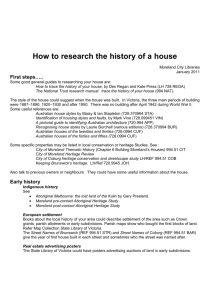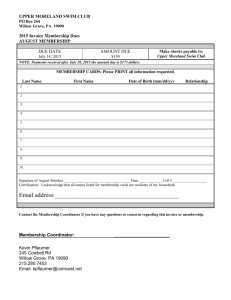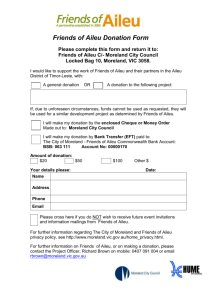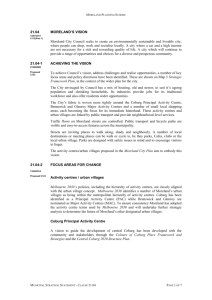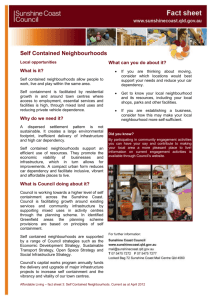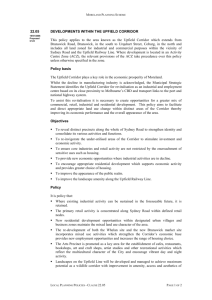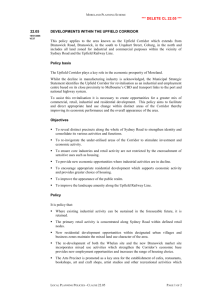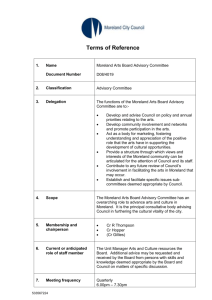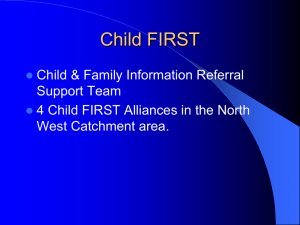ministerial direction - Moreland City Council
advertisement
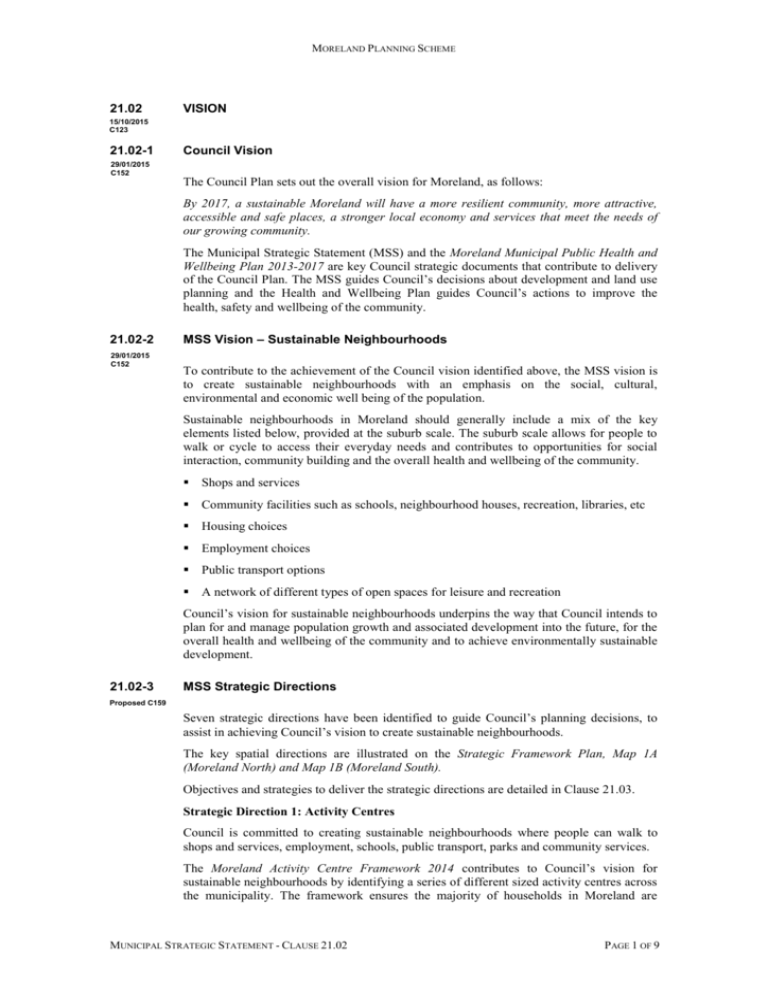
MORELAND PLANNING SCHEME 21.02 VISION 15/10/2015 C123 21.02-1 Council Vision 29/01/2015 C152 The Council Plan sets out the overall vision for Moreland, as follows: By 2017, a sustainable Moreland will have a more resilient community, more attractive, accessible and safe places, a stronger local economy and services that meet the needs of our growing community. The Municipal Strategic Statement (MSS) and the Moreland Municipal Public Health and Wellbeing Plan 2013-2017 are key Council strategic documents that contribute to delivery of the Council Plan. The MSS guides Council’s decisions about development and land use planning and the Health and Wellbeing Plan guides Council’s actions to improve the health, safety and wellbeing of the community. 21.02-2 29/01/2015 C152 MSS Vision – Sustainable Neighbourhoods To contribute to the achievement of the Council vision identified above, the MSS vision is to create sustainable neighbourhoods with an emphasis on the social, cultural, environmental and economic well being of the population. Sustainable neighbourhoods in Moreland should generally include a mix of the key elements listed below, provided at the suburb scale. The suburb scale allows for people to walk or cycle to access their everyday needs and contributes to opportunities for social interaction, community building and the overall health and wellbeing of the community. Shops and services Community facilities such as schools, neighbourhood houses, recreation, libraries, etc Housing choices Employment choices Public transport options A network of different types of open spaces for leisure and recreation Council’s vision for sustainable neighbourhoods underpins the way that Council intends to plan for and manage population growth and associated development into the future, for the overall health and wellbeing of the community and to achieve environmentally sustainable development. 21.02-3 MSS Strategic Directions Proposed C159 Seven strategic directions have been identified to guide Council’s planning decisions, to assist in achieving Council’s vision to create sustainable neighbourhoods. The key spatial directions are illustrated on the Strategic Framework Plan, Map 1A (Moreland North) and Map 1B (Moreland South). Objectives and strategies to deliver the strategic directions are detailed in Clause 21.03. Strategic Direction 1: Activity Centres Council is committed to creating sustainable neighbourhoods where people can walk to shops and services, employment, schools, public transport, parks and community services. The Moreland Activity Centre Framework 2014 contributes to Council’s vision for sustainable neighbourhoods by identifying a series of different sized activity centres across the municipality. The framework ensures the majority of households in Moreland are MUNICIPAL STRATEGIC STATEMENT - CLAUSE 21.02 PAGE 1 OF 9 MORELAND PLANNING SCHEME within walking distance (i.e. approximately 400 metres) of an activity centre and have local access (i.e. approximately one kilometre) to a centre that meets their weekly convenience needs (i.e. Coburg, Brunswick or Glenroy Activity Centres or a Neighbourhood Centre). Coburg, Brunswick and Glenroy Activity Centres are the larger centres in the framework. These centres provide a broad mix of retail uses (including convenience and comparison shopping), commercial and cultural activity, a diverse mix of employment options and are generally well served by public transport. These centres are preferred locations for administrative and civic centre functions and should be prioritised for government investment and regional facilities. These three centres are identified to accommodate the most significant change of all the activity centres. Change and intensification should be consistent with the directions set out in the relevant zones and overlays and the following strategic plans – the Coburg Place Framework 2010 and Central Coburg 2020 Structure Plan 2006, the Brunswick Structure Plan 2010 and Addendum 2012 and the Glenroy Structure Plan 2008. A series of smaller Neighbourhood and Local Activity Centres are also identified in the Moreland Activity Centre Framework. Neighbourhood Centres (NCs) provide a mix of uses to meet daily and weekly needs of the local community. They generally include (or have the potential to include) shops, a supermarket, small service businesses, coffee shops, medical/health clinics, public transport and limited community services. They play an important community role in providing health and community services and a place to meet and socialise within the local area. Change and intensification should be consistent with the directions set out in Schedule 24 to the Design and Development Overlay (DDO24) which is based on the Moreland Neighbourhood Centres Strategy, 2015. Moreland’s Neighbourhood Centres are located as follows: Grantham/Union Streets, West Brunswick Melville Road/Albion Street/Victoria Street, West Brunswick /Nicholson Street/Holmes Street/Moreland Road, Coburg / Brunswick Bell Street/Melville Road, Pascoe Vale South Gaffney Street/Pascoe Vale Station, Pascoe Vale Gaffney/Sussex Streets, Coburg North Elizabeth Street, Coburg North West Street, Hadfield Bonwick Street, Fawkner Snell Grove, Oak Park Merlynston Station, Merlynston Moreland/Melville Roads, West Brunswick Local Centres (LCs) play an important role in ‘plugging the gaps’ in the activity centre network and ensuring there is good access across the municipality to local shopping services. These centres serve daily convenience needs of the local community. The housing directions for activity centres are outlined under Strategic Direction 3 below. Council is committed to complementing the creation of vibrant activity centres with an improved public realm of streets and public spaces, and by ensuring the provision of adequate infrastructure required by the growing and changing population. Strategic Direction 2: Land for Industry and Economic Regeneration MUNICIPAL STRATEGIC STATEMENT - CLAUSE 21.02 PAGE 2 OF 9 MORELAND PLANNING SCHEME Council is committed to the continued presence of industry and other commercial businesses within the municipality for the contribution these businesses make to a sustainable economy and a diversity of employment opportunities. The Moreland Industrial Land Use Strategy 2006 (MILUS) protects three Core Industry and Employment Precincts in Brunswick, North Coburg and Newlands, and a number of smaller Secondary Industry and Employment Precincts scattered across the municipality. These industrial precincts have been identified for long term retention in industrial zones. They are relatively unconstrained by residential or other sensitive uses and are intended to remain as priority areas for long term investment in industrial and other compatible businesses. A select number of specific precincts of industrial zoned land have been identified as Multi Use – Employment Precincts, reflecting their suitability to transition to accommodate a wider mix of commercial uses to contribute to economic regeneration and more diverse employment opportunities. These areas are predominantly located within or adjacent to activity centres and their transition will support and reinforce the economic and employment objectives of activity centres. Residential uses in these precincts will only be supported if priorities for employment have been addressed. A limited number of industrial areas – Multi Use – Residential Precincts and Transition – Residential Precincts will also contribute to housing supply in Moreland. Council will be undertaking a review and update of the MILUS over 2014/15. Council is committed to complementing economic regeneration with programs to support local economic development and to facilitate business investment decisions. Strategic Direction 3: Housing Council will facilitate housing development to meet the needs of the growing and diverse population, with a focus on: Providing a range of housing sizes and types to accommodate a diversity of household sizes Housing affordability Housing designed to be visitable by people with limited mobility, and adaptable for residents with specific accessibility requirements. Housing Growth and Change In planning for population growth and diversity, Council will facilitate increases in housing supply and housing choice, based on: A suburb’s access to shops, services and public transport The existing diversity of dwelling stock in a suburb. The approach to facilitating character change and increased density housing in locations close to shops, services and public transport has been integrated with the objective to provide for housing choice and diversity. In some locations where there is poor housing choice and a predominance of detached dwellings (suburbs north of Moreland Road), Council will seek to increase the amount of multi dwelling developments. In other locations there is an increasing predominance of multi dwelling housing types (suburbs south of Moreland Road) and Council will seek to retain some areas for single dwellings and lower density multi dwellings. Areas have been designated for significant, incremental and minimal housing growth, as outlined below, and this is reflected in the application of the three residential zones – Residential Growth Zone (RGZ), General Residential Zone (GRZ) and Neighbourhood Residential Zone (NRZ). Significant Housing Growth MUNICIPAL STRATEGIC STATEMENT - CLAUSE 21.02 PAGE 3 OF 9 MORELAND PLANNING SCHEME Significant growth is encouraged within Moreland’s three large Activity Centres and in Moreland’s twelve Neighbourhood Centres (as listed below). Increased housing densities in the form of apartments and townhouses are encouraged in these activity centres. In these locations, neighbourhood character is expected to change over time, commensurate with the role and size of the centre in the overall network of centres. Larger Centres: Coburg Activity Centre Brunswick Activity Centre Glenroy Activity Centre Neighbourhood Centres: Grantham/Union Streets, West Brunswick Melville Road/Albion Street/Victoria Street, West Brunswick Nicholson Street/Holmes Street/Moreland Road, Coburg/Brunswick Bell Street/Melville Road, Pascoe Vale South Gaffney Street/Pascoe Vale Station, Pascoe Vale Gaffney/Sussex Streets, Coburg North Elizabeth Street, Coburg North West Street, Hadfield Bonwick Street, Fawkner Snell Grove, Oak Park Merlynston Station, Merlynston Moreland / Melville Roads, West Brunswick Coburg, Brunswick and Glenroy Activity Centres should accommodate a significant increase in medium and higher density housing in accordance with the relevant zones and overlays and the following strategic documents Coburg Place Framework 2010 and Central Coburg 2020 Structure Plan, 2006, the Brunswick Structure Plan 2010 and Addendum 2012 and the Glenroy Structure Plan 2008. These plans define the boundary for the relevant centre where significant change is encouraged. The plans also define the preferred built form outcomes within each centre’s boundary. The Neighbourhood Centres (NCs) listed above are also planned to accommodate an increase in housing supply and are preferred locations for increased density housing (although at a lesser rate of change to the three larger centres) in accordance with DDO24 which is based on the Moreland Neighbourhood Centres Strategy 2015. The Commercial 1 Zone (CZ1), Mixed Use Zone (MUZ) and Residential Growth Zone (RGZ) define the total extent of area within these centres where increased densities are encouraged. These areas are expected to experience a change in character towards a more dense urban environment, with housing predominantly apartment and townhouse style in buildings of three to four storeys. Incremental Housing Growth Incremental housing growth and change is encouraged around the activity centres designated for growth (as listed above) and around train stations. The extent of area for incremental change is defined by the General Residential Zone (GRZ). In incremental change areas, multi dwelling infill developments in the form of townhouses and units will continue to be encouraged. New development must be designed to respect existing neighbourhood character and contribute to an enhanced landscape character. MUNICIPAL STRATEGIC STATEMENT - CLAUSE 21.02 PAGE 4 OF 9 MORELAND PLANNING SCHEME Minimal Housing Growth The remainder of Moreland’s residential areas will be retained for minimal housing growth to ensure an ongoing supply of single dwellings and low density multi dwelling developments, with an enhanced open and landscaped character. These areas are defined by the Neighbourhood Residential Zone (NRZ). In minimal change areas, multi dwelling infill development will be allowed, but at a lower density to that otherwise achievable under ResCode (Clause 55). The emphasis in the NRZ areas is on the creation of an enhanced open and landscaped character, by providing increased private open space and landscaping. Council is committed to complementing residential areas with improved street tree planting, well maintained parks and associated community facilities, and safe and convenient pedestrian environments. Housing Affordability Housing affordability refers to purchase price, rental price and ongoing living costs (utilities, transport) associated with the design and location of housing. Genuine efforts to deliver housing affordability on all three fronts will be strongly supported by Council. Council seeks to ensure the provision of housing choice and to use energy efficiency and transport policy to reduce the ongoing living costs associated with the design and location of housing. As committed in the Moreland Affordable Housing Strategy 2014-2018, Council will continue to advocate for reform to the Victorian planning system to address housing affordability, specifically through inclusionary zoning. Liveable Housing Housing needs for individuals and families can change due to a range of factors, including age, temporary or permanent injury or impairment, and disability. To address these issues, Council requires all new dwellings in Moreland to be designed so they can be visited by people whose mobility is constrained. Council also seeks to increase the housing stock in the municipality that is designed to be accessible (i.e. is suitable to be lived in by people whose mobility is impaired) or can be easily adapted to provide accessibility features. Strategic Direction 4: Good Design In managing population growth and associated development, Council is committed to improving the quality of design of the built environment. Good design is intrinsically linked to safety, health and well being and environmental sustainability. The MSS includes specific directions to improve design quality overall, with a particular emphasis on site responsive design, passive design for energy efficiency, integration with the public realm and integration with landscape design. Council specifically supports the design principles associated with Crime Prevention Through Environmental Design (CPTED), Healthy by Design, Food Sensitive Urban Design, Child Friendly Cities and Livable Design. These principles inform Council’s work associated with the urban environment and underpin the sustainable neighbourhoods vision of the MSS. Strategic Direction 5: Environmentally Sustainable Development Council is committed to best practice environmentally sustainable development (ESD). Development should integrate the principles of sustainable design early in the design process, at the planning stage, for the following benefits: Easier and cheaper compliance with building requirements through passive design Reduced living costs associated with housing, such as energy costs Improved amenity and liveability Reduced greenhouse gas emissions MUNICIPAL STRATEGIC STATEMENT - CLAUSE 21.02 PAGE 5 OF 9 MORELAND PLANNING SCHEME Greater resilience to the impacts of climate change (such as heat waves). The MSS includes specific ESD objectives and strategies for energy efficiency, waste management and integrated water management. Broader aspects of environmentally sustainable development are integrated across the MSS to deliver the overall vision for sustainable neighbourhoods (such as urban consolidation in activity centres and the integration of transport and land use planning). Strategic Direction 6: Open Space Network The Moreland Open Space Strategy 2012-2022 identifies an open space network for leisure, recreation and nature conservation purposes. The network includes sports fields, conservation areas, playgrounds and recreation trails, as well as public land provided for drainage and utility purposes that is used or valued for leisure and environmental purposes. In addition to ‘green’ open space, other public spaces enhance the recreation, leisure and social opportunities of the community, especially within activity centres. These spaces may be paved such as town squares or public plazas. Streetscapes also make a significant contribution to the overall provision of public spaces in Moreland. Specific areas in Moreland have been assessed as deficient in the provision of open space, and these are identified on the Strategic Framework Plan (Map 1A and 1B). These areas will be prioritised for the provision of new open space as opportunities arise. In particular, any rezoning proposals within these areas will be reviewed for the potential to create new open space. The MSS includes directions to protect and enhance the open space network. Strategic Direction 7: Transport Network The Moreland Integrated Transport Strategy 2010 outlines a transport system that supports sustainable communities. The key principles of this transport system are: Walking and cycling are the preferred modes of transport Good public transport services in all areas Streets are community spaces Local access to services, education and employment. Council encourages integrated transport and land use planning that will support residents and visitors to reduce their travel by ensuring access to local services, education and employment. Council will continue to advocate for improved public transport services and grade separation at Glenroy Road, Glenroy and Bell Street, Coburg. Freight and commercial vehicle access to activity centres and Core and Secondary Industrial and Employment Precincts will be protected in recognition of the needs of businesses. The Strategic Framework of the MSS is predicated on developing sustainable neighbourhoods by integrating transport and land use planning decision making which maximise people’s opportunities to walk, cycle and use public transport. 21.02-4 Particular Issues 15/10/2015 C123 In addition to the key strategic directions included in the MSS, there are a range of particular issues Council has developed specific local planning policies for to guide the exercise of discretion. The local planning policies are located in Clause 22, as follows: 22.01 Neighbourhood Character 22.02 Discretionary Uses in Residential Zones 22.03 Car and Bike Parking and Vehicle Access MUNICIPAL STRATEGIC STATEMENT - CLAUSE 21.02 PAGE 6 OF 9 MORELAND PLANNING SCHEME 22.04 Advertising Signs 22.05 Caretakers Houses 22.06 Heritage 22.07 Development of Five or More Storeys MUNICIPAL STRATEGIC STATEMENT - CLAUSE 21.02 PAGE 7 OF 9 MORELAND PLANNING SCHEME Map 1A and 1B Strategic Framework Plan MUNICIPAL STRATEGIC STATEMENT - CLAUSE 21.02 PAGE 8 OF 9 MORELAND PLANNING SCHEME MUNICIPAL STRATEGIC STATEMENT - CLAUSE 21.02 PAGE 9 OF 9

